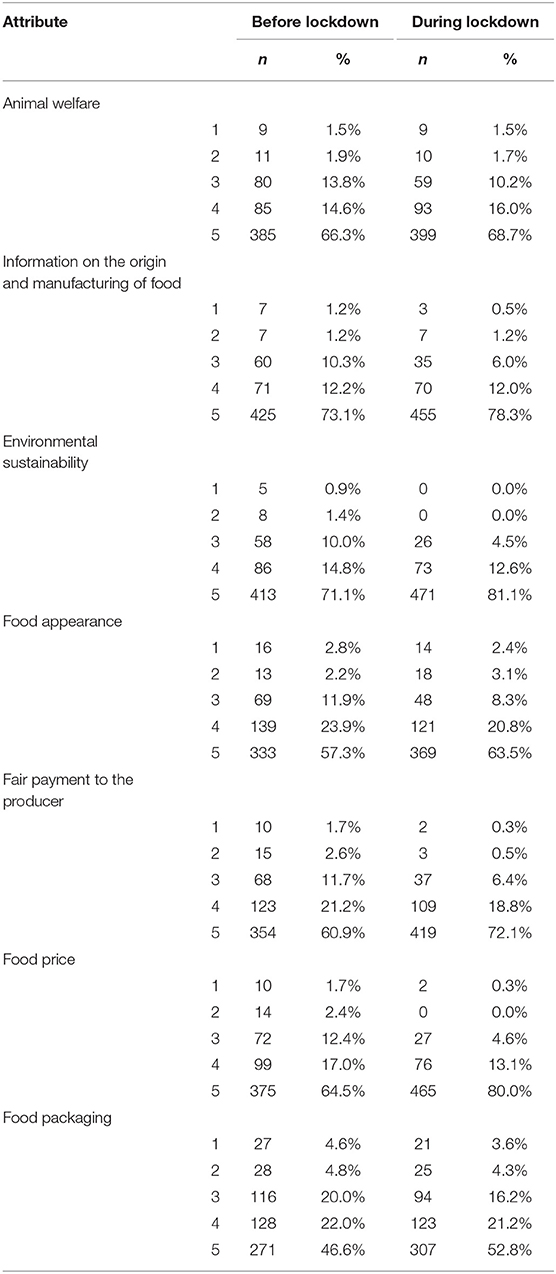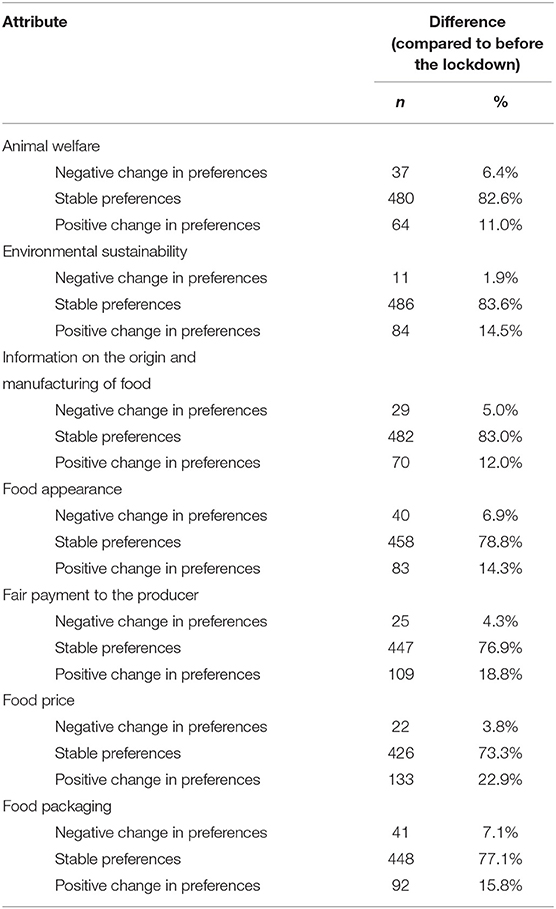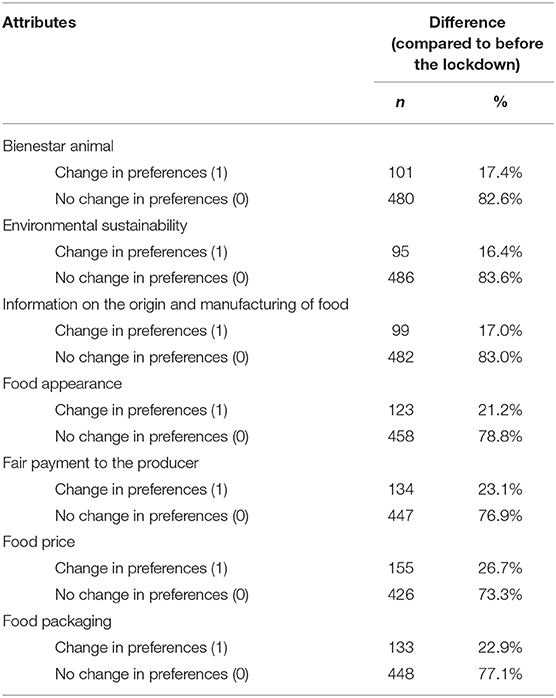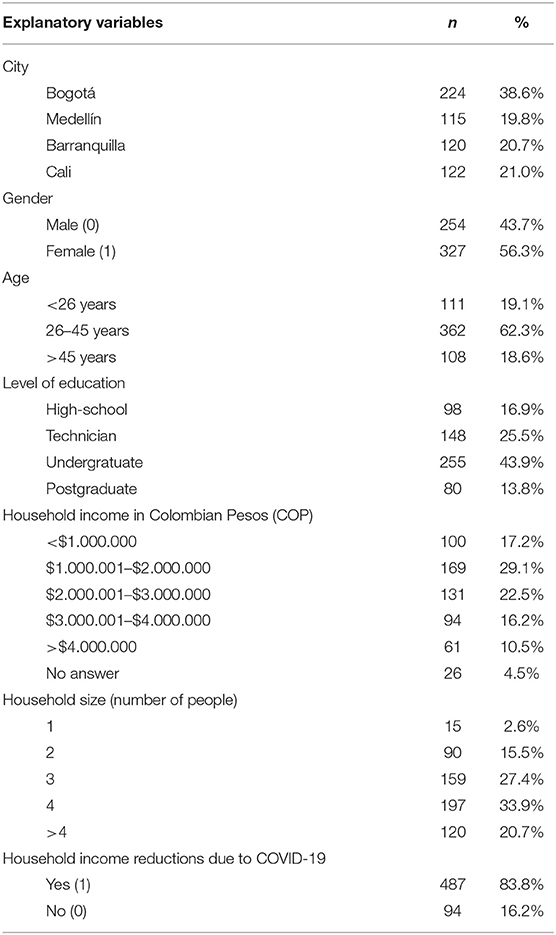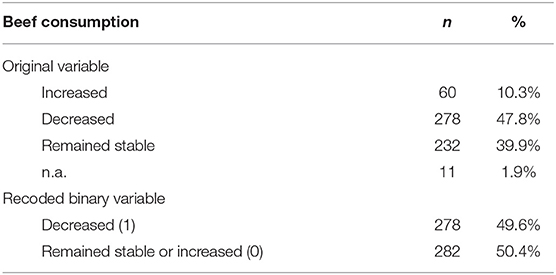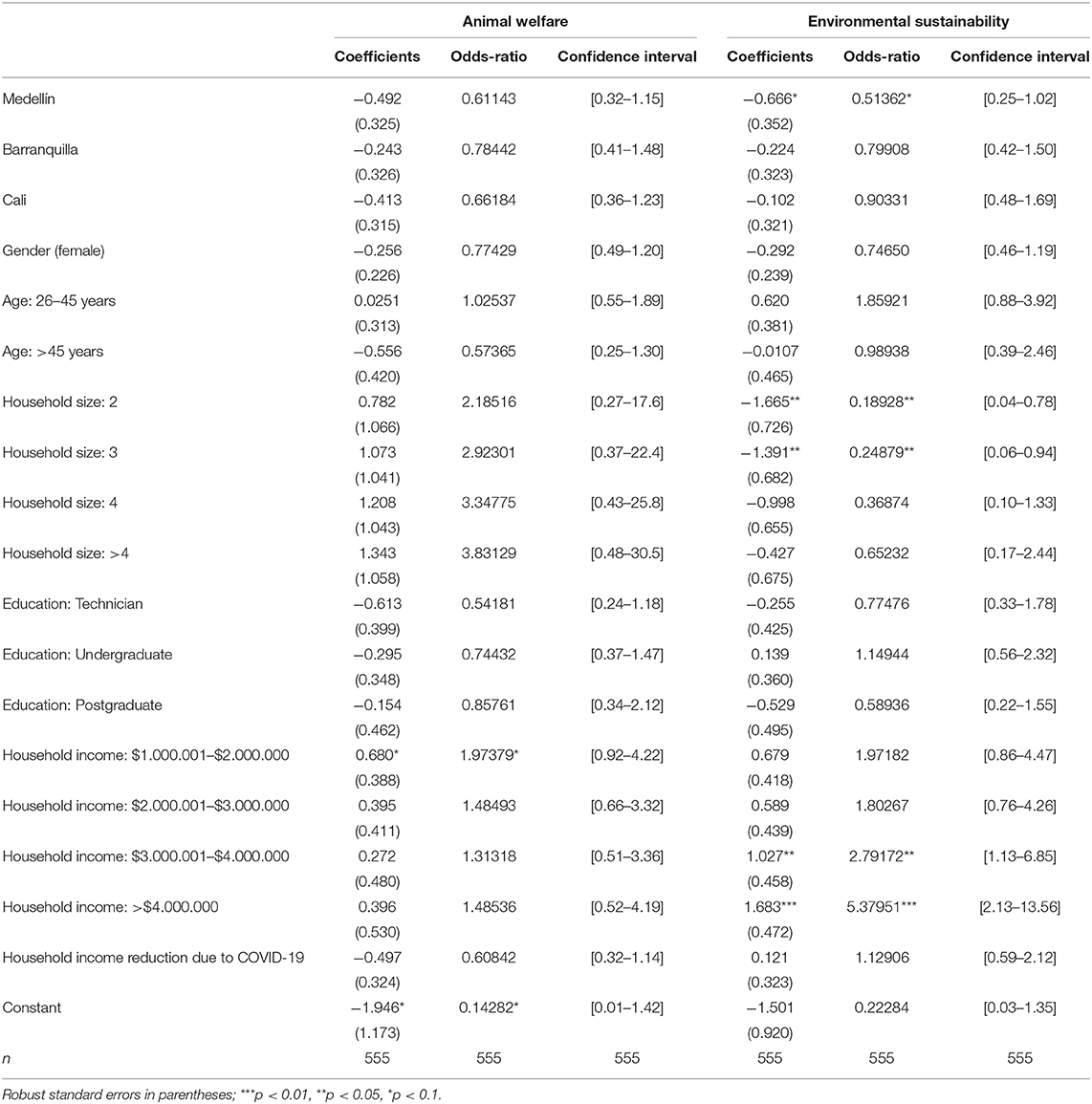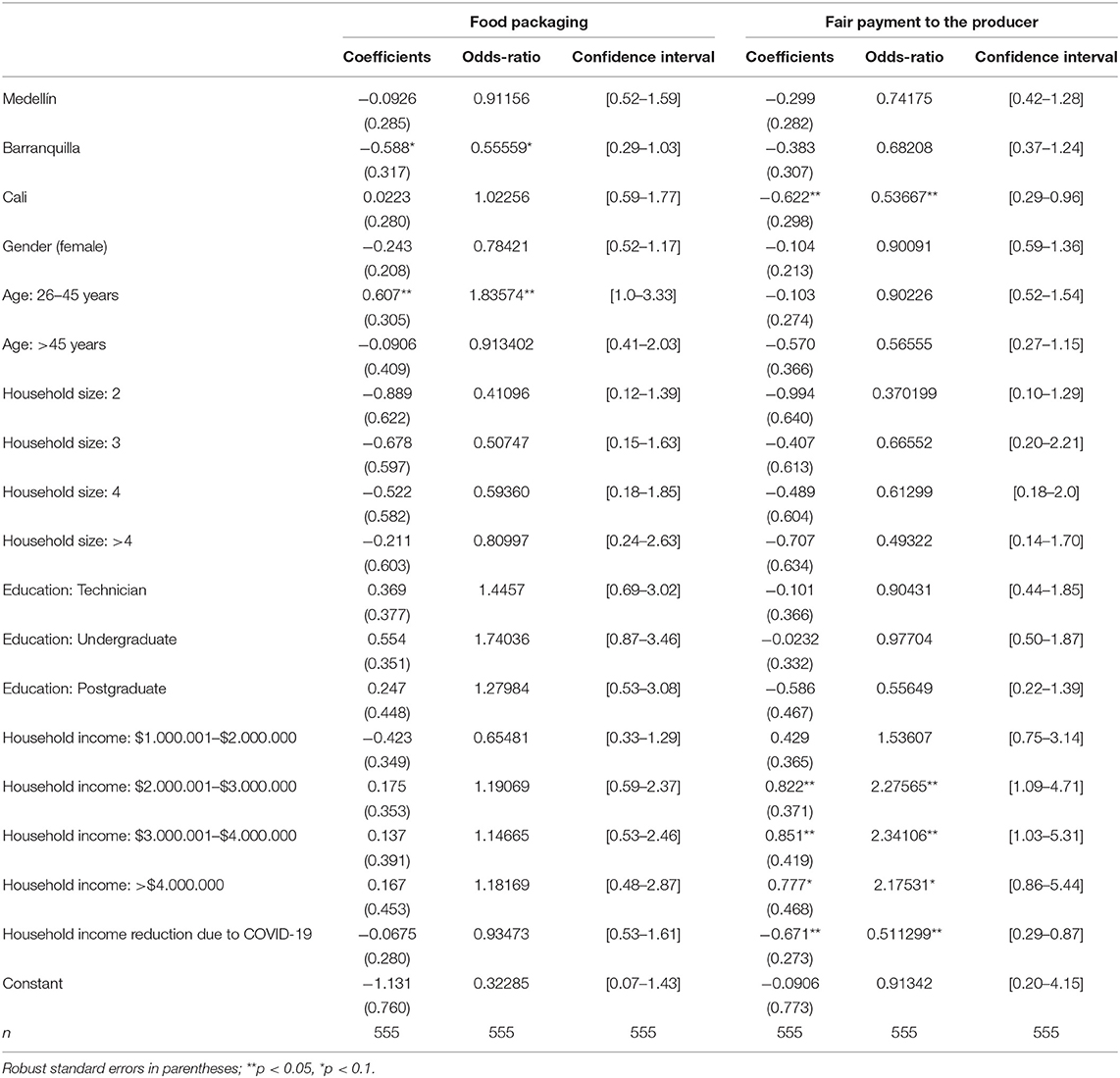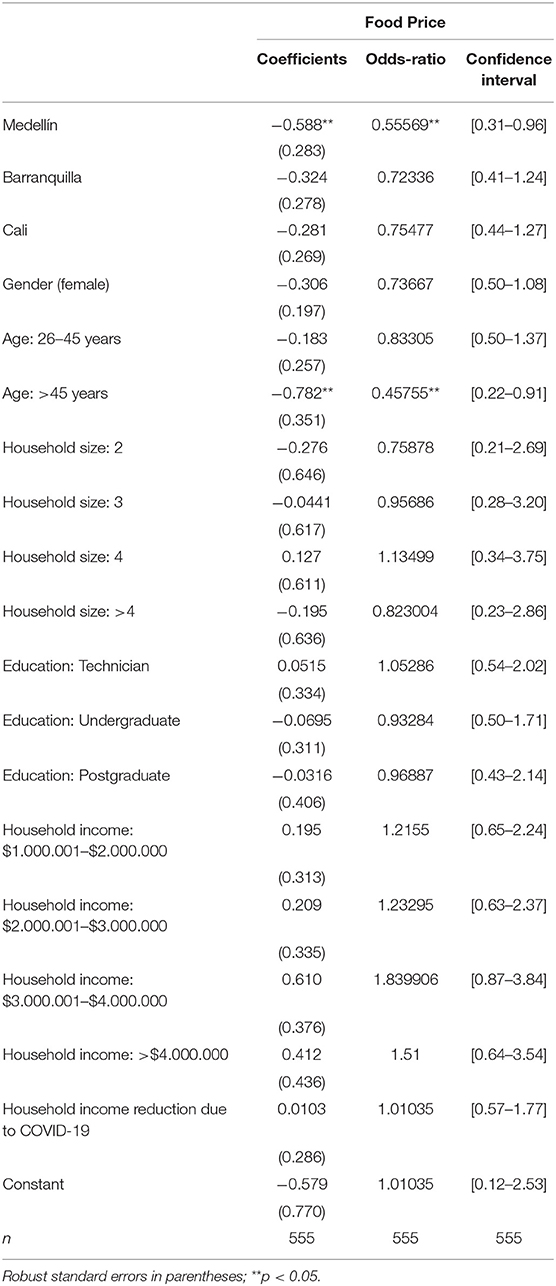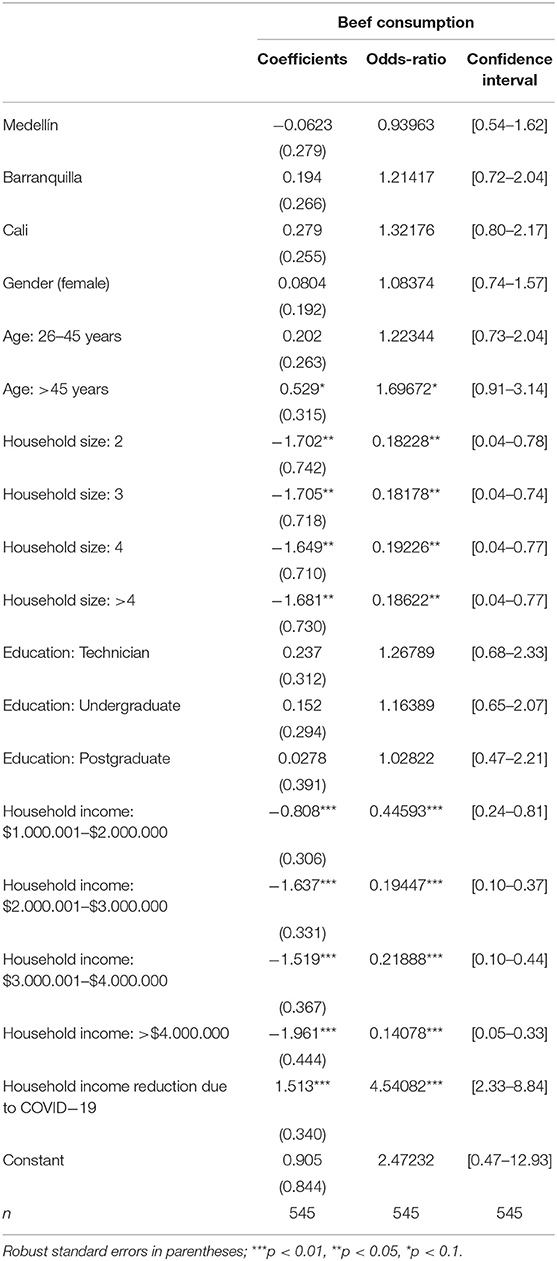- 1Independent Researcher, Cali, Colombia
- 2Alliance Bioversity International and CIAT, Cali, Colombia
The COVID-19 pandemic has brought impacts on the food system in several ways, such as on the supply and demand of food or changes in consumer preferences. However, little is known yet about these effects but needs to be analyzed to define actions and policies for crisis mitigation and achieving food system resilience and food security. In this article, we estimate the effect of the COVID-19 lockdown on changes in food consumer preferences in Colombia, applying a logit model approach for seven attributes, namely animal welfare, environmental sustainability, information on the origin and manufacturing of food, food appearance, food price, fair payment to the producer, and food packaging. In addition, we provide an analysis of changes in beef consumption during the lockdown, since the beef industry is among Colombia's most important agricultural activities and is heavily affected by substitution effects. Our results show that consumer beliefs regarding these attributes remained mostly stable, but that income is a determining factor for the decision to consume certain types of food, such as beef, rather than for possible changes in beliefs. This means that income ends up being decisive for the consumption of food such as beef and that, for its part, it does not have a greater weight in the change of beliefs of the people surveyed. The results will help the food system actors in defining interventions for achieving food security and resilience.
Introduction
The occurrence of COVID-19, declared a pandemic by the World Health Organization (WHO) on March 10 2020, has brought profound social and economic disturbances. The viruses' high contagiousness and its impact on the numbers of patients with need for support from the health systems have caused the implementation of various prevention measures by the governments of most nations in order to control the spread of the disease, such as travel restrictions, changes in work and study places, social distancing, quarantines, or lockdowns, among others (Addisson et al., 2020; Deb et al., 2020; Warwick and Roshen, 2020). These measures, however, have caused different economic shocks, with a particular emphasis in developing economies. According to the International Monetary Fund (2021), for Latin America and the Caribbean, this resulted in a 7% decrease of the region's gross domestic product in 2020, despite predicted scenarios by the United Nations (2020) of decrease of 9% in the worst case. The pandemic has posed risks to the achievement of the Sustainable Development Goals (SDG) for 2030, such as (i) no poverty (UN-SGD 1), (ii) zero hunger (UN-SGD 2), and (iii) responsible production and consumption (UN-SGD 12), among others. FAO et al. (2019) stated that hunger in Latin America and the Caribbean was already increasing before COVID-19 and, according to FAO and CELAC (2020), the pandemic puts more households at risk of food insecurity, increasing the number of people suffering from hunger and challenging difficulties for adequate nutrition, in addition to an increase in poverty. In the worst-case scenario, there could be a 10% increase of people living from less than US$ 5.5 per day in Latin American and the Caribbean (Sumner et al., 2020), highlighting the impact of the pandemic on the socioeconomic conditions of households and food security.
The crisis resulting from the pandemic, however, is not limited to its economic effects. The Lancet (2020a) describes that there is a double interrelated crisis, as the pandemic came along right in the middle of an environmental crisis. According to Rasul (2021), the environmental crisis and the pandemic are manifested especially in the agricultural sector, since, on the one hand, climate change has effects on e.g., production capacities, the quality of the land, or the amount of rainfall and its predictability, while, on the other hand, the pandemic brought with it effects on e.g., regional and global food chains, the relations between food producers and consumers, food prices, employment through mobility restrictions or quarantines, and consumer behavior and preferences.
The effects on consumer preferences are directly resulting from changes in people's daily lives and living conditions. Households challenge income reductions and, in turn, change their food consumption decisions, causing e.g., substitution effects or panic buying behavior. The stability of the food system is being affected, too, since disruptions at different food chain levels, such as production, processing, distribution and commercialization, cause alteration in production volumes and prices. According to FAO and CELAC (2020), these changes can bring food security problems in several ways. On the demand side, there is a reduction in household income and a reduction in food consumption, or even a change in the quality of the food that households have access to. On the supply side, there are e.g., changes in food prices, the reduction in production volumes as a result of COVID-19 measures, difficulties in accessing productive inputs (e.g., insecticides, machinery, seeds), and the closure of borders causing a reduction of food and input imports and exports.
The present study has the objective of analyzing how beef consumer preferences and beliefs in Colombia are being affected during the COVID-19 pandemic. Through logit regression models, we aim at identifying the effects of sociodemographic variables on changes in food consumer preferences for a set of selected attributes, such as animal welfare and environmental sustainability, among others. In this sense, the research question is: Are there changes in the consumption of beef and changes in people's beliefs as consequences of the COVID-19 pandemic and the associated lockdown in Colombia, and are there differential effects among different sociodemographic parts of the population? The results of this study are key for understanding food consumer's valuation of preferences in situations of unexpected shocks and if these valuations change and generate, in the short or long term, a new conception of different aspects of food consumption. We also apply a logit regression model to project the food consumer decision on beef consumption in the midst of the COVID-19 pandemic, since the Colombian beef industry is (i) suffering from substitution effects (DANE-ESAG, 2020a,b); and (ii) undergoing a transition process toward achieving more sustainability and resilience (Rao et al., 2015; Rudel et al., 2015). This model makes it possible to investigate whether sociodemographic factors have a pattern between consumption decisions and assessments of various aspects of consumption. Having knowledge about changes in preferences and beliefs brings with it implications for food security and sustainable consumption, since we are part of a food system whose parts are linked to each other (Béné, 2020), such as for example organic and local products (Bernard and Liu, 2017) or the willingness for changing diets (Wang and Scrimgeour, 2021).
In this sense, this article is structured as follows: Section two provides a conceptual framework on food systems and consumer preferences, a literature review on the effects of the pandemic on food supply and demand, and the policies that have been implemented used to face the effects of the pandemic. Section three describes the methodology and models used, section four provides the results, section five the discussion and Section six the conclusions and recommendations.
Materials and Methods
Theoretical Framework
The Covid-19 pandemic is an unforeseen event and the magnitude of its effects has no clear precedents. In this sense, the conceptual framework for understanding the impacts of the pandemic on changing consumer preferences starts from a vision of the food system, at a global level, to a micro context on consumption decisions and consumer preferences. Furthermore, this conceptual framework highlights how shocks affect the food system and how they can cause changes in consumer preferences.
For this purpose, it is important to understand the food system concept. Ericksen (2008) posits the food system and food security as an interaction between the global environmental and socioeconomic changes as determinants of the activities and results of the food system. The activities in the system are the production, processing, distribution, sale and final consumption of food. The results of the system are the availability, accessibility and utilization of food, as well as the stability of the food system. FAO (2008) clarifies that these last four elements are the basis for food security and are aspects to consider for facing malnutrition and hunger.
In this sense, it is important to understand how food systems and production or value chains work at a global level, since this allows to identify the possible impact channels of shocks such as the COVID-19 pandemic or climate change. Laborde et al. (2020), for example, state that there are effects on the four elements related to food security, which, while showing the severity of the pandemic, allows addressing the problem by differentiating between the elements of the food system. In this sense, Béné (2020) presents an overview of the various direct and indirect effects of the pandemic on the food system. Among these, the reduction in income and productive activities of all actors in the food chain are highlighted, as well as possible externalities between the parts of the production chain. For this reason and despite the unpredictability of shocks such as the pandemic, it is required to take into consideration the resilience capacities of the food system, and to put its reaction capacity as a central element in the framework and policies of the system.
Consumer preferences are mainly related to the accessibility and use in the food system. Russo et al. (2021) propose a general scheme for changing preferences in the framework of the COVID-19 pandemic. Consumption decisions depend on habits, restrictions in the context of the pandemic and psychological pressures. These aspects intervene in the purchase decision in the short term and, if consumer habits and experiences are valued positively in the long term, this would imply changes in consumer preferences in the short and long term. Carolan (2021) carried out a study on the ethical consumption of food and on activism and how changes in consumer behavior can be identified within the framework of the pandemic. Larios-Gómez et al. (2021) show results for Mexico, Colombia and Ecuador, posing changes in consumer behavior, identifying differences between the countries, and emphasizing the inclusion of technology and the analysis of temporary behaviors such as hoarding, among others.
It should be clarified that preferences regarding consumption decisions are mediated by beliefs, since these end up being determining attributes when choosing a good for consumption (Martínez-Cañas et al., 2016; Bernard and Liu, 2017; Merlino et al., 2018; Banovic et al., 2019; Zhang et al., 2020; Wang and Scrimgeour, 2021). In this sense, we consider that beliefs about animal welfare and environmental sustainability, among others, make a fundamental part of the set of elements that we consider as preferences. This means that, although a differentiation is being made between preferences for beef consumption decisions and preferences as beliefs about different aspects of consumption, we still place this study in the context of analysis of consumer preferences. Even though this expression would be framed as beliefs within the consumer theory, we consider them to be in relation with the consumption decisions, since such ethical considerations can influence and change consumption decisions. In addition, it should be clarified that our study is centered on changes in preferences (preferences and beliefs) and on the evaluation of differences among population segments. In this sense, our study follows the hypothesis that changes in preferences and beliefs occur in the face of unexpected shocks, such as the COVID-19 pandemic. Although cultural changes happen in a slower or gradual way, the effects of the pandemic, given its magnitude and scope, could bring along changes much faster than expected, since daily life was affected and psychological effect of quarantines can have impacts on personal decisions (Russo et al., 2021; Vázquez-Martínez et al., 2021).
This theoretical framework allows us to roughly consider the context in which this research is located, namely, the changes in consumer preferences and beliefs in the Colombian food system.
Literature Review
The literature on the effects of the COVID-19 pandemic is very varied. There are several articles that investigate the effects on the economy, health systems, mental health, the aggravation of poverty and risk conditions, the effects on the environment, or food waste. In addition, there are studies that emphasize the pandemic as an opportunity for change. For example, Cohen (2020) states that the pandemic would be, despite the various difficulties it causes, an opportunity to generate a transition toward sustainable consumption, considering that this is one of the United Nations Sustainable Development Goals.
Nevertheless, the pandemic has brought various consequences, which are found on the spectrum of the entire food system. People have changed their consumption decisions and change their consumption preferences, at the same time that the production, distribution and sales within the value chains is affected by the COVID-19 measures and policies. Siche (2020), for example, states that the effects of the pandemic could be divided into supply effects and demand effects. This, in turn, allows us to divide the literature review into three subsections: the effects of the pandemic on (i) food supply, (ii) food demand, and (iii) response policies to these effects. In this sense, the literature search was carried out based on keywords such as COVID-19, impacts on the food system, food chain policies in the context of the pandemic, food supply and demand in the context of COVID-19. The search was carried out in the ScienceDirect and Scopus databases, selecting the articles by relevance, both by citations and by relation to the subject of this article. We sought to obtain articles that studied the impact of the pandemic in different countries, since this allows for a contrast between the policies implemented and the results obtained by different countries, considering studies for both the supply of and the demand for food. This literature review was intended to provide insights into the implications of the COVID-19 pandemic on the food system, in such a way that the results of our study could be put into context.
This context on the effects of the COVID-19 pandemic on food supply and demand allows us to understand the magnitude of the crisis on the food system and, as well, to link the effects of supply and demand on the beef consumption decisions and consumer beliefs, since the psychological pressures of the pandemic, consumption expectations and proposed solution policies generate scenarios where people can change their decisions both regarding consumption and their beliefs (Martínez-Cañas et al., 2016; Russo et al., 2021; Wang and Scrimgeour, 2021). Thus, the literature review frames the range of possible causes, at least theoretical, of the change in consumer preferences and beliefs.
Effects of the COVID-19 Pandemic on Food Supply
Food value chains are challenging various effects resulting from the COVID-19 pandemic. These are, however, not homogeneous and may vary depending on the particular country or value chain. In principle, part of the productive capacity is limited by strong social distancing measures, quarantines or lockdowns, among others (FAO and CELAC, 2020). In the agricultural sector, for example, labor plays a significant role and, especially at the beginning of the pandemic, people were confined to their homes or faced mobility restrictions for a long period of time, causing a reduction in the overall food production. Blazy et al. (2021) compiled information for the Caribbean, highlighting the seriousness of food system deficiencies in various countries, and raise the need to improve food system resilience and response capacity. This point is crucial in regions and countries where production is periodic, since in these cases, migratory processes of workers affect the labor availability within the food system. Regarding mobility restrictions, a large part of the migrant labor force was unable to reach the harvest sites and food production was reduced. Tougeron and Hance (2021), for example, show the effects of the pandemic on apple production in Europe, ensuring that, although production was affected by the periodic nature of apples, the main effects were seen in increased costs, i.e., for labor, packaging and distribution.
Another effect on the value chains and food systems price increases and the availability of productive inputs. In some countries, border closures and panic regarding the supply capacity of food systems resulted in export and import limitations of both food and agricultural inputs. De Boef et al. (2021) described these effects for different crops in Ethiopia, Myanmar, Nigeria and Uganda and conclude that a lack of seeds and labor, among others, causes disruptions in the value chains and food systems.
The literature also identifies different impacts of the pandemic on female and male producers. Alvi et al. (2021) show that women from India and Nepal are being affected by a limited to productive inputs and the quality of the land to produce food. Nchanji and Lutomia (2021) highlight the different effects between men and women and the South and East African regions, showing a greater impact in the South African region and especially on young women. This not only shows that the impact of the pandemic has different magnitudes between countries, but that there are also differences between population groups.
Djekic et al. (2021) conducted a survey with companies from 16 countries, identifying staff awareness and hygiene as the two central points for companies to safeguard food safety amid the pandemic. This is in contrast to Ilesanmi et al. (2021), who, for Nigeria, emphasize the effects on food production capacity and the periodicity of crops, and consider the impact of mobility policies for field workers as fundamental for the pursuit of food safety, even more than individual COVID-19 protection measures.
In this sense, the COVID-19 pandemic decreased agricultural production and in turn increased production costs, given supply problems and product shortages (FAO and CELAC, 2020; FAO and ECLAC, 2020; Ilesanmi et al., 2021). This generated an increase in food prices for the final consumer, which in turn has effects on the amount and types of food that households consume and can compromise household food security.
Effects of COVID-19 on Food Demand
The COVID-19 pandemic is also affecting the demand for food. Consumption decisions are generally related to numerous aspects, such as economic capacity, taste and purchase expectations, and COVID-19 added to this the fear of contagion through food. Gómez-Corona et al. (2021) described the effects of fear in consumption decisions through case studies in Mexico, Peru and Spain, and show the prevalence of fear of food shortages in relation to food safety, and the fear of infections in relation to the interaction with food, leading to technological changes in the purchase of food products (Burkart et al., 2020; Larios-Gómez et al., 2021), since consumers, in the context of the pandemic, do not seem to follow a cultural behavior, but rather adapt their preferences to the context, adopting other forms of consumption such as online food purchase. There is also a change in the use of food services, such as restaurants, resulting from COVID-19 measures, such as social distancing and temporary closures (Burkart et al., 2020), which imply a change in the food consumed by households and increases food preparation at home (FAO and ECLAC, 2020).
In some cases, this has led to an increase in the demand for food and, in turn, a food hoarding effect resulting from the fear of food insecurity (Burkart et al., 2020; Song et al., 2021). Additionally, many households challenge income reductions due to lockdown measures or loss of employment, which is compromising food security (FAO and ECLAC, 2020). This in turn brought with it changes in consumption preferences, since households have access to less food due to the increase in prices and supply problems and in turn there is a change in the diet and nutrition of the foods they decide to consume (FAO and ECLAC, 2020; Ilesanmi et al., 2021; Russo et al., 2021), leading to substitution effects in some cases (Burkart et al., 2020; Sullivan and Amos, 2020; Trujillo, 2020). All these factors are determinants of food demand, defining the global capacity of the food system and food security, which can cause food losses and increased poverty (FAO, 2008; The Lancet, 2020b).
Proposed Response Policies to Lessen the Effects of COVID-19 on the Food System
Response policies and measures to the pandemic are multifold and depend on each country and region in question. There exist some common denominators, however, that raise the need to take the COVID-19 crisis as a possibility to restructure and renew food systems, including the addressing of topics such as (i) food system resilience, (ii) sustainable production and consumption, and (iii) the effects of climate change on food systems (Béné, 2020; Zhan and Chen, 2021). This section provides a brief overview of some of the proposed response policies aimed at mitigating the effects of COVID-19, in order to contextualize the various alternatives depending on the particular contexts of each country.
The responses for achieving a resilient food system, according to Zhan and Chen (2021) for the case of China, are the early identification of alterations in the agricultural sector, guaranteeing the functioning of the logistical structure of the sector, and the inclusion of technological tools to facilitate the exchange between consumer and producer. Long-term investments in the agricultural sector are also mentioned, such as the creation of a risk prevention system, where government participation is key to guaranteeing food security. Han et al. (2021) compiled a series of policies that the FAO recommends to mitigate the impact of the pandemic. Among them is the implementation of social assistance and food protection programs, keeping the agricultural sector active by solving any logistical setback, supporting the productivity of small production units and the inclusion of contact technologies.
Béné (2020) raises the need to create more resilient food systems, and points out that the pandemic could be an alternative to generate that resilience, through greater cooperation and diversification of production, generating greater inclusion in agricultural activities and entrepreneurship. Zimmerer and de Haan (2020) describe the importance considering the informal agricultural sector and using the pandemic framework to generate more robust food systems. Talukder et al. (2021) state that in order to minimize the impact of the pandemic on agriculture in Bangladesh, it is necessary to maintain the functioning of food production, guarantee access to productive inputs, increase governmental participation, invest in better storage systems and incorporate the use of technology, among others.
The International Food Policy Research Institute (IFPRI, 2021) raises the need for a more resilient food system that is capable of absorbing shocks such as those generated by the pandemic and that public and private sector innovation is crucial. Pirasteh-Anosheh et al. (2021) describe haloculture, a system to cultivate crops in arid zones based on the use of highly saline water and soil resources, as an option to generate new strategies to combat food insecurity, given its ability to cultivate crops on arid lands. Workie et al. (2020) propose other mitigation strategies, such as the decentralization of the food system, monetary transfers to groups at risk, the generation of food programs and the provision of international support.
In general, there are many policies that have been proposed to face the COVID-19 pandemic. Some programs are focused on mitigating the effects on demand and others on supply. The perception that the pandemic is an opportunity to build a more resilient food system is, however, widely acknowledged, and considers both the effects of the pandemic and climate change.
Data Sources
The data for this study were obtained in July 2020 in the four major cities of Colombia: Bogotá, Medellín, Cali and Barranquilla. A representative sampling was applied by socioeconomic strata (2 to 6). Socioeconomic stratification in Colombia categorizes housing units in a scale of one to six according to their physical characteristics, immediate surroundings and rural or urban context. It was implemented for assigning differential public utilities rates to different strata, enabling higher strata (five and six) to pay higher rates and subsidize the costs for lower strata (one, two and three).
The company Cluster Research carried out data collection and applied a non-probability sampling, where people were randomly selected to participate in this study. 581 units have been recruited virtually (given the quarantine restrictions in Colombia), in a self-administered process and through a virtual information collection platform. Target group were food consumers with knowledge of their household food expenses and participation in the preparation of food at their homes, since this is one of the fundamental filters to study consumer decisions, beliefs and behaviors. This survey had the purpose of identifying the perception of COVID-19, attitudes, and behaviors around food consumption, as well as to obtain socioeconomic variables. It should be noted that the information on the assessment of beliefs was obtained through the recall method, since the people surveyed were asked at a single point in time for their beliefs and preferences before and during the lockdown.
Methodology
Binomial logit regression analysis is a methodology used to identify the relevant factors in changing consumer preferences (McFadden, 1974). These models allow to identify the relevance of factors in the probability of occurrence of a phenomenon compared to the occurrence of a base event. This can be seen in Equation (1):
Equation (1) refers to the estimation of the probability of the variable yi, which represents the variables changes of preferences and changes of beliefs, from a series of explanatory variables xi, which are the sociodemographic variables of the people surveyed. In this sense, the logit model is estimated through the maximum likelihood method, since this is a non-linear model.
In Equation (2), the cumulative probability function is specified, which in this case is a logistic function, represented by:
Equation (2) is equivalent to Equation (1) only that the probability function in Equation (2) is made explicit. yi and xi represent the same variables as in the case of Equation (1). Table 1 provides an overview on the distribution of consumer beliefs for selected attributes before and during the COVID-19 lockdown in Colombia, which began in March 2020. The categories take values from 1 to 5, where 1 is equivalent to not important at all and 5 to very important. For each of the variables, two questions were asked capturing the valuation of the consumers before and during the lockdowm.
To estimate the binomial logit regression model, the variables are transformed so that there are only two values, as represented in Equation (3):
In this sense, the variables to be explained were constructed from the difference of the valuations and recoding the variables in such a way that they are binary. If the variable takes the value of 1, this implies that there were changes in the beliefs of the surveyed person, while if it takes the value of 0, the beliefs remained stable within the framework of the lockdown caused by the pandemic. It should be noted that, as shown in Table 2, there are consumers with stable beliefs, while others changed their beliefs in a positive or negative way. If the change is negative, the person had a higher rating of the attribute before the pandemic, which then declined during the lockdown. A positive change means that the consumer had a lower rating of the attribute before the pandemic, which then increased during the lockdown. These changes are grouped in Table 3, where we include the binary variables of changes in beliefs (negative or positive) with respect to the stability of beliefs. This information is provided for the seven attributes of interest in the article, namely (i) animal welfare, (ii) environmental sustainability, (iii) information on the origin and manufacturing of food, (iv) food appearance, (v) food price, (vi) fair payment to the producer, and (vii) food packaging.
We also consider sociodemographic variables, such as gender, age, household size, educational level, and income level. Table 4 describes the explanatory variables of the model. It should be noted that all the variables are categorical, so the estimations are interpreted with respect to a base category for each variable. In this sense, we apply the following binomial logit regression model:
Equation (4) proposes the estimation of the probability of yi as a function of the explanatory variables xi. Seven logistic models are estimated for the variations in consumer beliefs represented by the variable yi, and in this sense, there are seven dependent variables that represent the changes for the above-mentioned seven attributes. Each of the seven logistic models depends on the sociodemographic characteristics, where Cityi represents the city in which the surveyed person lives (Bogotá, Medellín, Cali, Barranquilla), Genderi describes the sex of the person (male or female), Agei is the range of age of each person, NHousehold represents the number of people living the household, Educationi refers to the educational level of the person, Incomei to the household income, and YCovid19i is a binary variable that identifies if the person's household income decreased due to COVID-19. β0 is a constant parameter, and β1, β2, β3, β4, β5, β6 y β7 are those parameters associated with each of the sociodemographic variables. The statistical significance of these parameters is what allows us to identify if there are differential effects in the change of beliefs of the surveyed consumers.
In addition to the described models, we also apply a logit model that provides estimations on the change in the consumption of beef, since the Colombian beef industry is (i) suffering from substitution effects (DANE-ESAG, 2020a,b); and (ii) undergoing a transition process toward achieving more sustainability (Rao et al., 2015; Rudel et al., 2015). Table 5 shows the frequencies of these variables. To estimate the model, the variable is transformed in such a way that it has only two categories: decreased or increased beef consumption. Table 5 also shows the frequency for the recoded variable, which is the dependent variable in the logit model for beef consumption. The logit model for beef consumption has the same structure as provided for the general binomial logit regression model in Equation (4).
The results of the estimates, both for the models of changes in beliefs and the beef consumption model, include the significance of the estimation coefficients, which account for the type of relationship between the variables, and the odd-ratio, which allows to compare the probability of occurrence of the change in beliefs, given each of the explanatory variables. In addition, as mentioned in the theoretical framework, the approach to consumer preferences is understood as the decision to consume goods itself (in this case beef) and the set of beliefs that influence consumption decisions (animal welfare, fair prices to producers, among others).
The results of the estimates provided in Tables 6–10 and explained in the subsequent section should be read understanding the concept of base categories. In the case of the variable city, the results for Medellín, Cali and Barranquilla are set in comparison with Bogotá, meaning that Bogotá has no estimation coefficient, and that the estimation coefficient for the other cities identifies a differential effect of the probability of changes in consumer beliefs compared to Bogotá. In the case of the gender variable, the base category is male and the coefficient of the estimate is the differential effect for female consumers have compared to male ones. For the variable age, level of education, household income, household size and household income reduction due to COVID-19, the base categories are <26 years, high school, <$1,000,000 Colombian Pesos, one person and no income reduction, respectively.
Robustness Check
A first robustness exercise is done by considering the different ways in which beliefs regarding attributes can change during quarantine. For this purpose, different categories are being considered that reflect types of changes for the evaluated attributes, meaning that if the category of the attribute changes by a single level (either positive or negative) or if it changes by more than one level. We recognize that the change in beliefs may occur to a lesser or greater extent and that the magnitude of this change must be considered. Thus, the transformation from binary to categorical variables explained in the methodology was made and considers four scenarios:
This approach allows us to consider with a broader spectrum the real change in beliefs regarding the studied attributes and complement the objectives of the document. The figures resulting from the categorical transformation for changes in beliefs show that the imbalance problem is not solved, on the contrary it intensifies. This means that the changes in beliefs regarding the attributes are low during the lockdown, and that disaggregating several categories that model such changes only generates more imbalance among the categories, reinforcing the idea of considering the transformation to binary variables as most appropriate. In this sense, the changes of beliefs for the studied attributes, in empirical terms, is more telling if at least one change is grouped and the permanence in the initial category is dissolved, even recognizing that the change of beliefs handles a single scale.
Results
Before presenting the results of the binomial logit regression models, it is worth highlighting the characteristic of the beliefs for the people surveyed. Table 1 shows that the majority of the survey participants (60–80%) have strong beliefs for the majority of the included attributes [except food appearance (57.3%) and food packaging (46.6%)], shedding light on the unbalanced nature of consumer beliefs. In addition, there is a high percentage of people who did not change their beliefs during the COVID-19 lockdown. Table 2 shows, for example, that for animal welfare, 82.6% of the people did not change their beliefs, and for environmental sustainability it was 83.6%, information on the origin and manufacturing of food 83%, food appearance 78.8%, fair payment to the producer 76.9%, food price 73.3%, and food packaging 77.1%, respectively. These results are decisive, since they denote an important result: people have a high valuation of attributes and, in the face of the shock caused by the COVID-19 pandemic, most people did not change their preferences and beliefs.
Another relevant result are the positive and negative changes in consumer beliefs presented in Table 2. Although the majority of the survey participants did not change their beliefs, there exist some differences in the percentages of positive and negative changes in consumer beliefs. The highest percentage of positive changes is related to the attribute food price (22.9%), followed by fair payment to the producer (18.8%). This means that during the COVID-19 lockdown, these two attributes became more important to about one fifth of the surveyed food consumers. Negative changes in consumer beliefs, however, are also visible and the highest changes relate to the attributes food packaging (7.1%) and food appearance (6.9%), highlighting that these attributes became less important to a small fraction of the surveyed consumers during the lockdown. These results indicate that the surveyed consumers prioritize access to food (price) and a constant flow of food (fair payment to producers) over other aspects such as food packaging and food appearance.
On the other hand, the results of the estimations show a general lack of significance of the explanatory variables with respect to changes in beliefs. This is notorious for the seven estimated models, even though in some cases the variables are significant, but not conclusive. Tables 6–9 compile the results for the model estimates and show the coefficients and odds-ratio for each model.
Table 6 shows the results for animal welfare and environmental sustainability. In the case of the animal welfare model, the only variable that is significant is household income for those households in the second salary range (compared to the lowest salary range), indicating that there is a greater probability of changing beliefs with increasing incomes. This is, however, not consistent, since for the following salary ranges there are no significant changes, suggesting that there is no clear trend regarding the influence of household income on the change of belief for animal welfare. In the case of the environmental sustainability model, consumers who live in Medellín are less likely to change their beliefs compared to those who live in Bogotá. Additionally, households with a size of 2-3 people are less likely to change their beliefs compared to single-person households. In addition, the model suggests that households with the highest incomes are more likely to change their beliefs compared to those in the lowest category.
Regarding food appearance, Table 7 shows that there are significant differences between men and women, with women being less likely to change their beliefs regarding. No significant results were found for other sociodemographic variables in this case. In the case of information on the origin and manufacturing of food, Table 7 shows significant results in consumer beliefs related to household income, suggesting that those higher household incomes are more likely to generate changes in consumer beliefs. Table 8 shows the results for food packaging and suggests that people living in Barranquilla have a lower probability of changing their beliefs compared to those living in Bogotá. Age also plays a role in this attribute, since the age group from 26–45 is more likely to change their beliefs compared to younger consumers. Table 8 also provides the results for the attribute fair payment to the producers, and differences can be observed between cities, with people living in Cali to be less likely to change their beliefs compared to those living in Bogotá. Also, households with higher incomes are more likely to change their beliefs. This is being reaffirmed with the variable on income reduction due to COVID-19, since affected households are less likely to change their beliefs compared to people whose income was not reduced. Table 9 shows the results for the food price attribute, suggesting that people living in Medellín are less likely to change their beliefs compared to those who live in Bogotá. Also, younger people (<26) are more likely to change their beliefs than older ones (>45).
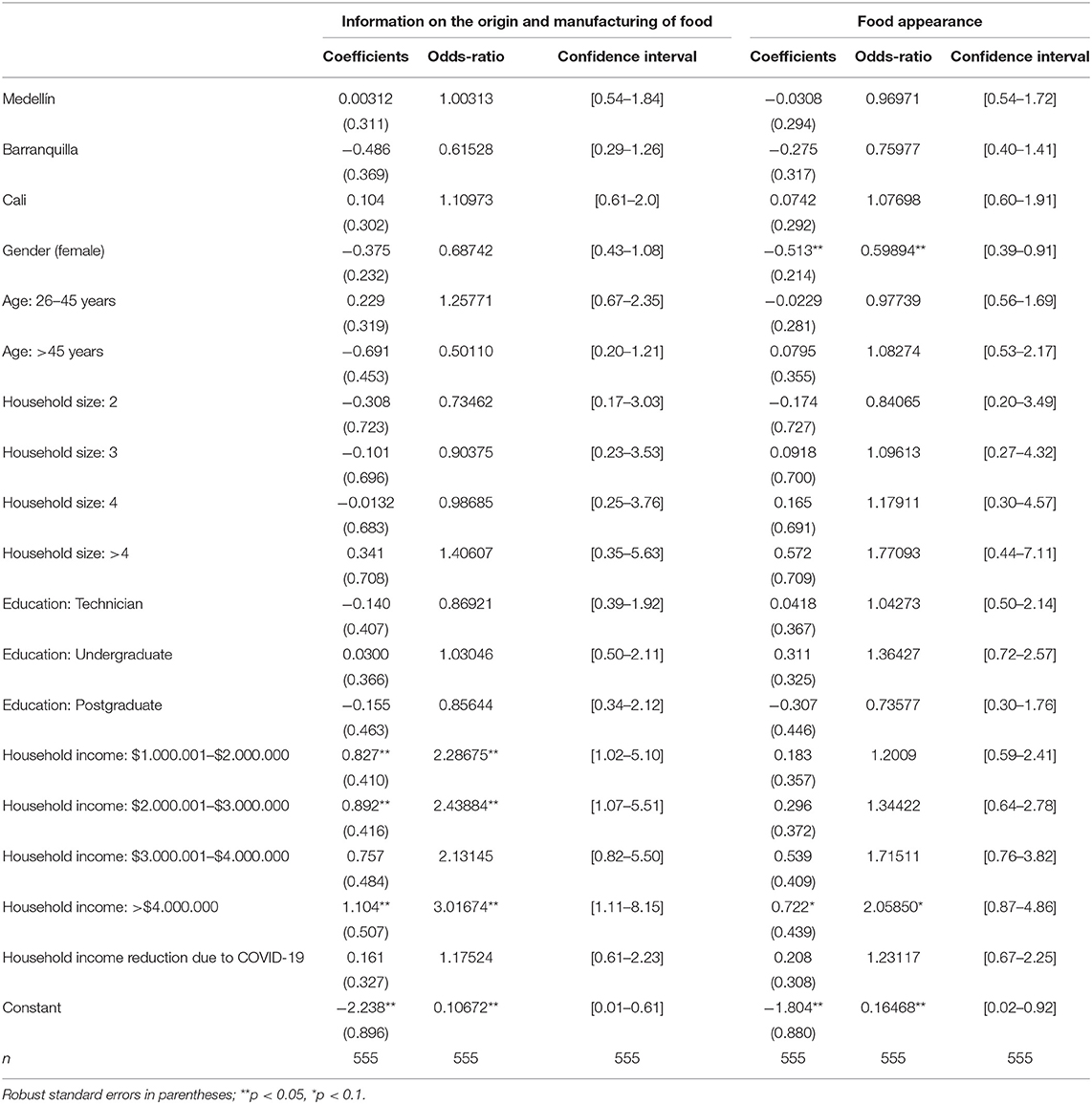
Table 7. Logit model results for the attributes information on the origin and manufacturing of food and food appearance.
Table 10 provides the results for the beef consumption model. Larger households are less likely to reduce their beef consumption compared to single-person households and the same occurs for households with higher incomes. Households whose income was affected by COVID-19 are more likely to reduce their beef consumption, suggesting a substitution effect of beef during the lockdown.
Despite the fact that our results are not fully conclusive, some trends can be identified: (i) there are differences between cities for some of the attributes, (ii) gender seems to have little influence on changes of preferences and beliefs, (iii) for some attributes, younger people are more likely to change their preferences and beliefs, and (iv) household income seems to be the most relevant variable regarding changes in preferences and beliefs, with higher income households being more likely to change their beliefs and less likely to reduce beef consumption.
Discussion
Understanding changes in consumer preferences and beliefs in the face of the COVID-19 pandemic shock on the food system, is key to the development of action policies for and within the food system and for achieving food security and food safety. The results presented in this article for Colombia reaffirm a part of what is described in the literature, because consumer beliefs remain stable in the face of shocks such as the COVID-19 pandemic. Consumption preferences are affected by external shocks (Béné, 2020; Russo et al., 2021), such as in Colombia the consumption of beef, which has declined as, i.e., among lower-income households or households that faced income reductions due to the pandemic. This raises the need for policies related to household income or the search for income stability with the goal of reducing the risk of food insecurity.
The effect of the COVID-19 related lockdown in Colombia is not very noticeable in the change of consumer beliefs regarding various attributes, such as animal welfare, environmental sustainability, information on the origin and manufacturing of food, food appearance, food price, fair payment to the producer, and food packaging. Consumer beliefs rather remained stable, and the evaluated attributes receive a generally high valuation among food consumers. This is contrary to what was expected at the beginning of the pandemic, where long-term changes in consumer preferences and beliefs toward more sustainability, animal welfare or fair trade were projected for Latin America and Colombia (Burkart et al., 2020; Sullivan and Amos, 2020; Trujillo, 2020). It also could affect the pre-COVID-19 efforts of the agriculture and livestock sector in Colombia, which were strongly oriented toward the development of sustainable products with price-premiums (Charry et al., 2018, 2019; Ruden et al., 2020). No clear differences were found in relation to sociodemographic variables. This is contrary to other studies suggesting relevant differences between age groups in the case of external shocks, such as climate change (Andor et al., 2018; Burlea-Schiopoiu et al., 2021). In this sense, it seems that the impact of the pandemic on the assessment of certain preferences and beliefs was not decisive to change them.
The results of the beef consumption model are consistent with what is described in the literature (FAO and CELAC, 2020), suggesting that changes in household income result in the adaptation of households and the substitution of more expensive food with cheaper alternatives (Sullivan and Amos, 2020). The difference between the high percentage households who faced income reductions during the COVID-19 lockdown (83.8%) and the more moderate percentage of those who reduced the consumption of beef (47.8%) is interesting and suggests that beef consumption does not decrease proportionally to decreasing household incomes. This is an interesting fact for the value chain actors and public policy agents, since it shows the high relevance of beef in the Colombian food basket. In this sense, considering both income decreases and beef consumption, a substitution effect happens in the food basket and beef consumption declines (although unproportionally) – a situation which will only change once incomes increase again.
The results shown in this article have limitations regarding the methodology used. On the one hand, they may be biased given the imbalance in the proportion of people who changed beliefs compared to those who did not change beliefs. The logit model methodology is susceptible to inconclusive results in cases of unbalanced samples for the dependent variable. In our case, the dependent variable beliefs, for example, takes the value of 1 if beliefs change and 0 if they do not change the fact that beliefs do not change (takes the value of 0), resulting in an imbalanced division (and not 50:50). Such disproportion in the dependent variable can generate biases in the results, provided that the imbalance is too noticeable (King and Zeng, 2001; Kubus, 2020). Future studies should consider the collection of data among samples of a larger size, which would allow obtaining a balanced subsample and thus model preferences with a lower risk of bias. In addition, it is important to consider the limitations of our results resulting from data collection with the recall method. In future studies, the information could be collected in two or more points in time, in addition to including validation questions regarding preferences and beliefs. It is also necessary to expand the studies on consumer preference changes in the face of the COVID-19 pandemic, since, although there is extensive literature on the pandemic's impacts on the food system, there is not much literature on its effects on consumer beliefs.
Conclusions
The COVID-19 pandemic crisis has brought various impacts and changes in the food system. One of the most notorious is the risk of achieving the Sustainable Development Goals for 2030 and the need for an active attitude to build a resilient and sustainable food system (Cohen, 2020; Galanakis, 2020). In the case of Colombia, the stability of people's beliefs in the face of the pandemic has become evident in this article, but vulnerability in food consumption was identified i.e., in the case of beef. This vulnerability results from the reduction in incomes due to the pandemic, which could potentially affect the household food baskets. It should be clarified that in this article, no assertion is being made about the causal links between one phenomenon or another, but rather a partial result is being provided that could be studied further. In this sense, the creation of policies that mitigate the impact of the pandemic on food demand and household well-being and incomes are key to achieving a stable, resilient, and fair food system.
Although literature for Colombia projected long-term changes in consumer preferences and beliefs toward more sustainability, animal welfare or fair trade because of the pandemic, the stability of consumer beliefs presented in this article might still contribute to the on-going efforts of the agriculture and livestock sector toward achieving more sustainability toward product differentiation efforts. Our results, however, show short-term impacts of the pandemic on consumer preferences and beliefs and this might still change in the medium- to long-term, requiring additional studies in the future. Future studies might further contribute to the analysis of the different effects on consumer preferences related to shocks such as climate change and COVID-19. This allows us to understand how preferences and beliefs are affected by various means and generate better policies for a food system capable of absorbing unexpected shocks such as the Covid-19 pandemic.
Data Availability Statement
The raw data supporting the conclusions of this article will be made available by the authors, without undue reservation.
Ethics Statement
The studies involving human participants were reviewed and approved by Ethics Committee of the Alliance of Bioversity International and CIAT, Cali, Colombia. The patients/participants provided their written informed consent to participate in this study.
Author Contributions
AC, KE, MD, and SB: conceptualization. OR, DM, AC, and KE: methodology. OR: formal analysis. OR, MD, and SB: writing the original draft and review and editing. AC, KE, MD, and SB: resources. SB: supervision, funding acquisition, and project administration. All authors contributed to the article and approved the submitted version.
Funding
This work was undertaken as part of the CGIAR Research Program (CRP) on Livestock.
Conflict of Interest
The authors declare that the research was conducted in the absence of any commercial or financial relationships that could be construed as a potential conflict of interest.
Publisher's Note
All claims expressed in this article are solely those of the authors and do not necessarily represent those of their affiliated organizations, or those of the publisher, the editors and the reviewers. Any product that may be evaluated in this article, or claim that may be made by its manufacturer, is not guaranteed or endorsed by the publisher.
Acknowledgments
We thank all donors that globally support the work of the CRP programs through their contributions to the CGIAR system.
References
Addisson, T., Kunal, S., and Finn, T. (2020). Covid-19: Macroeconomic Dimensions in the Developing World. United Nations University. Working doi: 10.35188/UNU-WIDER/2020/831-3
Alvi, M., Barroah, P., Gupta, S., and Saini, S. (2021). Women's access to agriculture extension amidst COVID-19: Insights from Gujarat, India and Dang, Nepal. Agric. Syst. 188, 103035. doi: 10.1016/j.agsy.2020.103035
Andor, M., Schmidt, C. M., and Sommer, S. (2018). Climate change, population ageing and public spending: evidence on individual preferences. Ecol. Econ. 151, 173–183. doi: 10.1016/j.ecolecon.2018.05.003
Banovic, M., Reinders, M., Claret, A., Guerrero, L., and Krystallis, A. (2019). “One Fish, Two Fish, Red Fish, Blue Fish”: How ethical beliefs influence consumer perceptions of “blue” aquaculture products? Food Qual. Prefer. 77, 147–158. doi: 10.1016/j.foodqual.2019.05.013
Béné, C. (2020). Resilience of local food systems and links to food security – a review of some important concepts in the context of COVID-19 and other shocks. Food Secur. 12:805–822. doi: 10.1007/s12571-020-01076-1
Bernard, J., and Liu, Y. (2017). Are beliefs stronger than taste? A field experiment on organic and local apples. Food Qual. Prefer. 61, 55–62. doi: 10.1016/j.foodqual.2017.05.005
Blazy, J. M., Causeret, F., and Guyader, S. (2021). Immediate impacts of COVID-19 crisis on agricultural and food systems in the Caribbean. Agric. Syst. 190, 103106. doi: 10.1016/j.agsy.2021.103106
Burkart, S., Díaz, M. F., Enciso Valencia, K., Urrea Benítez, J. L., Charry Camacho, A., and Triana Ángel, N. (2020). COVID-19 and the bovine livestock sector in Colombia: Current and potential developments, impacts and mitigation options. In: International Center for Tropical Agriculture (CIAT). Cali, Colombia. 36 p. https://hdl.handle.net/10568/108354
Burlea-Schiopoiu, A., Ogarca, R. F., Barbu, C. M., Craciun, L., Baloi, I. C., and Mihai, L. S. (2021). The impact of COVID-19 pandemic on food waste behaviour of young people. J. Clean. Prod. 294, 126333. doi: 10.1016/j.jclepro.2021.126333
Carolan, M. (2021). Practicing social change during COVID-19: Ethical food consumption and activism pre- and post-outbreak. Appetite 163, 105206. doi: 10.1016/j.appet.2021.105206
Charry, A., Jäger, M., Enciso, K., Romero, M., Sierra, L., Quintero, M., et al. (2018). Cadenas de valor con enfoque ambiental y cero deforestación en la Amazonía colombiana – Oportunidades y retos para el mejoramiento sostenible de la competitividad regional. In: CIAT Políticas en Síntesis No. 41. Centro Internacional de Agricultura Tropical (CIAT), Cali, Colombia. hdl.handle.net/10568/97203
Charry, A., Narjes, M., Enciso, K., Peters, M., and Burkart, S. (2019). Sustainable intensification of beef production in Colombia—Chances for product differentiation and price premiums. Agric. Food Econ. 7, 22. doi: 10.1186/s40100-019-0143-7
Cohen, M. J. (2020). Does the COVID-19 outbreak mark the onset of a sustainable consumption transition? Sustain. Sci. Pract. Pol. 16, 1–3. doi: 10.1080/15487733.2020.1740472
DANE-ESAG (2020a). Encuesta de sacrificio de ganado (ESAG) [Database]. DANE. Bogotá, Colombia. Available online at: bit.ly/2yI5Cd,K
DANE-ESAG (2020b). Censo Sacrificio de ganado total y departamental- vacunos, porcinos y otras especies-marzo 2020 [Database]. DANE. Bogotá, Colombia. Available online at: bit.ly/2XQbOcj
De Boef, W. S., Bornman, G. D., Gupta, A., Subedi, A., Thijssen, M. H., Aga, A. A., et al. (2021). Rapid assessments of the impact of COVID-19 on the availability of quality seed to farmers: Advocating immediate practical, remedial and preventative action. Agric. Syst. 188, 103037. doi: 10.1016/j.agsy.2020.103037
Deb, P., Furceri, D., Ostry, J., and Tawk, N. (2020). The effect of Containment Measures on the Covid-19 Pandemic. CEPR Discussion Paper No. DP15086. Available online at: doi: 10.5089/9781513550268.001
Djekic, I., Nikolic, A., Uzunovic, M., Marijke, A., Liu, A., Han, J., et al. (2021). Covid-19 pandemic effects on food safety - Multi-country survey study. Food Control 122, 107800. doi: 10.1016/j.foodcont.2020.107800
Ericksen, P. J. (2008). Conceptualizing food systems for global environmental change research. Global Environ. Change 18, 234–245. doi: 10.1016/j.gloenvcha.2007.09.002
FAO (2008). An Introduction to the Basic Concepts of Food Security. FAO. Rome, Italy. Available online at: http://www.fao.org/3/al936e/al936e.pdf
FAO and CELAC (2020). Seguridad Alimentaria bajo la Pandemia de COVID-19. FAO. Santiago de Chile, Chile.
FAO ECLAC (2020). Sistemas alimentarios y COVID-19 en América Latina y el Caribe: Hábitos de consumo de alimentos y malnutrición. Boletín No 10. Available online at: https://repositorio.cepal.org/bitstream/handle/11362/45794/1/cb0217_es.pdf
FAO FIDA, OMS, PMA y UNICEF. (2019). El estado de la seguridad alimentaria y la nutrición en el mundo 2019. Protegerse frente a la desaceleración y el debilitamiento de la economía. FAO. Rome, Italy. Available online at: http://www.fao.org/3/ca5162es/ca5162es.pdf
Galanakis, C. M. (2020). The food systems in the era of the coronavirus (COVID-19) pandemic crisis. Foods 9, 523. doi: 10.3390/foods9040523
Gómez-Corona, C., Rakotosamimanana, V. R., Sáenz-Navajas, M. P., Rodrigues, H., Franco-Luesma, E., Saldaña, E., et al. (2021). To fear the unknown: Covid-19 confinement, fear, and food choice. Food Qual. Prefer. 92, 104251. doi: 10.1016/j.foodqual.2021.104251
Han, S., Roy, P. K., Hossain, M. I., Byun, K. H., Choi, C., and Ha, S. D. (2021). COVID-19 pandemic crisis and food safety: implications and inactivation strategies. Trends Food Sci. Technol. 109, 25–36. doi: 10.1016/j.tifs.2021.01.004
IFPRI (2021). Global Food Policy Report: Transforming Food Systems after COVID-19. International Food Policy Research Institute. Washington, D.C.
Ilesanmi, F. F., Ilesanmi, O. S., and Afolabi, A. A. (2021). The effects of the COVID-19 pandemic on food losses in the agricultural value chains in Africa: the Nigerian case study. Public Health Pract. 2, 100087. doi: 10.1016/j.puhip.2021.100087
International Monetary Fund (2021). World Economic Outlook: Managing Divergent Recoveries. IMF. Washington, D.C. Available online at: https://www.imf.org/en/Publications/WEO/Issues/2021/03/23/world-economic-outlook-april-2021
King, G., and Zeng, L. (2001). Logistic regression in rare events data. Polit. Anal. 9, 137–163. doi: 10.1093/oxfordjournals.pan.a004868
Kubus, M. (2020). Evaluation of resampling methods in the class unbalance problem. Econ. Adv. Appl. Data Analy. 24, 39–50. doi: 10.15611/eada.2020.1.04
Laborde, D., Martin, W., Swinnen, J., and Vos, R. (2020). COVID-19 risks to global food security. Science 369, 500–502. doi: 10.1126/science.abc4765
Larios-Gómez, E., Fischer, L., Peñalosa, M., and Ortega-Vivanco, M. (2021). Purchase behavior in COVID-19: a cross study in Mexico, Colombia, and Ecuador. Heliyon 7, e06468. doi: 10.1016/j.heliyon.2021.e06468
Martínez-Cañas, R., Ruiz-Palomino, P., Linuesa-Langreo, J., and Blázquez-Resino, J. J. (2016). Consumer participation in co-creation: an enlightening model of causes and effects based on ethical values and transcendent motives. Front. Psychol. 7, 793. doi: 10.3389/fpsyg.2016.00793
McFadden, D. (1974). Conditional Logit Analysis of Qualitative Choice Behavior. In: Zarembka, Paul (ed.) (1974). Frontiers in Econometrics. Academic Press, New York. https://eml.berkeley.edu/reprints/mcfadden/zarembka.pdf
Merlino, V. M., Borra, D., Girgenti, V., Dal Vecchio, A., and Massaglia, S. (2018). Beef meat preferences of consumers from Northwest Italy: Analysis of choice attributes. Meat Sci. 143, 119–128. doi: 10.1016/j.meatsci.2018.04.023
Nchanji, E. B., and Lutomia, C. K. (2021). COVID-19 challenges to sustainable food production and consumption: future lessons for food systems in eastern and southern Africa from a gender lens. Sustain. Prod. Consumpt. (2021) 27, 2208–2220. doi: 10.1016/j.spc.2021.05.016
Pirasteh-Anosheh, H., Parnian, A., Spasiano, D., Race, M., and Ashraf, M. (2021). Haloculture: A system to mitigate the negative impacts of pandemics on the environment, society and economy, emphasizing COVID-19. Environ. Res. 198, 111228. doi: 10.1016/j.envres.2021.111228
Rao, I. M., Peters, M., Castro, A., Schultze-Kraft, R., White, D., Fisher, M., et al. (2015). LivestockPlus – The sustainable intensification of forage-based agricultural systems to improve livelihoods and ecosystem services in the tropics. Trop. Grasslands – Forrajes Tropic. 3, 59–82. doi: 10.17138/TGFT(3)59-82
Rasul, G. (2021). Twin challenges of COVID-19 pandemic and climate change for agriculture and food security in South Asia. Environ. Chal. 2, 100027. doi: 10.1016/j.envc.2021.100027
Rudel, T. K., Paul, B. K., White, D., Rao, I. M., Van der Hoek, R., Castro, A., et al. (2015). LivestockPlus: Forages, sustainable intensification, and food security in the tropics. AMBIO. 44, 685–693. doi: 10.1007/s13280-015-0676-2
Ruden, A., Castro, J. P., Gutiérrez, J. F., Koenig, S., and Arango, J. (2020). GANSO: New business model and technical assistance for the professionalization of sustainable livestock farming in the Colombian Orinoquia region. CCAFS Info Note. Cali, Colombia: CGIAR Research Program on Climate Change, Agriculture and Food Security (CCAFS). Available online at: https://hdl.handle.net/10568/110456
Russo, C., Simeone, M., Demartini, E., Marescotti, M. E., and Gaviglio, A. (2021). Psychological pressure and changes in food consumption: the effect of COVID-19 crisis. Heliyon 7, e06607. doi: 10.1016/j.heliyon.2021.e06607
Siche, R. (2020). What is the impact of COVID-19 disease on agriculture? Sci. Agropecuaria 11, 3–6. doi: 10.17268/sci.agropecu.2020.01.00
Song, S., Goh, J., and Tan, H. (2021). Is food security an illusion for cities? A system dynamics approach to assess disturbance in the urban food supply chain during pandemics. Agric. Syst. 189, 103045. doi: 10.1016/j.agsy.2020.103045
Sullivan, R., and Amos, N. (2020). How consumer concerns impact farm animal welfare. Innovation Forum, 2020. Available online at: bit.ly/36CmMWI
Sumner, A., Hoy, C., and Ortiz-Juarez, E. (2020). Estimates of the Impact of COVID-19 on Global Poverty. WIDER Working Paper 2020/43. doi: 10.35188/UNU-WIDER/2020/800-9
Talukder, B., van Loon, G. W., Hipel, K. W., and Orbinski, J. (2021). COVID-19's implications on agri-food systems and human health in Bangladesh. Curr. Res. Environ. Sustain. 3, 100033. doi: 10.1016/j.crsust.2021.100033
The Lancet (2020a). Climate and COVID-19: converging crises. Lancet 397:10269,10271. doi: 10.1016/S0140-6736(20)32579-4
The Lancet (2020b). COVID-19 in Latin America: a humanitarian crisis. Lancet 396:10261,11463. doi: 10.1016/S0140-6736(20)32328-X
Tougeron, K., and Hance, T. (2021). Impact of the COVID-19 pandemic on apple orchards in Europe. Agric. Syst. 190, 103097. doi: 10.1016/j.agsy.2021.103097
Trujillo, C. A. (2020). Puede el confinamiento por COVID 19 propiciar un estilo de vida y un consumo más sostenible? Available online at: bit.ly/2B4JCue
United Nations (2020). Policy Brief: The Impact of COVID-19 on Latin America and the Caribbean. Available online at: https://unsdg.un.org/resources/policy-brief-impact-covid-19-latin-america-and-caribbean
Vázquez-Martínez, U. J., Morales-Mediano, J., and Leal-Rodriguez, A. L. (2021). The impact of the COVID-19 crisis on consumer purchasing motivation and behavior. Eur. Res. Manage. Bus. Econ. 23, 100166. doi: 10.1016/j.iedeen.2021.100166
Wang, O., and Scrimgeour, F. (2021). Willingness to adopt a more plant-based diet in China and New Zealand: applying the theories of planned behaviour, meat attachment and food choice motives. Food Qual. Prefer. 93, 104294. doi: 10.1016/j.foodqual.2021.104294
Warwick, M., and Roshen, F. (2020). The economic impact of COVID-19. In: Economics in the Time of COVID-19. CEPR Press. Centre for Economic Policy Research. p. 45–51.
Workie, E., Mackolil, J., Nyika, J., and Ramadas, S. (2020). Deciphering the impact of COVID-19 pandemic on food security, agriculture, and livelihoods: a review of the evidence from developing countries. Curr. Res. Environ. Sustain. 2, 100014. doi: 10.1016/j.crsust.2020.100014
Zhan, Y., and Chen, K. Z. (2021). Building resilient food system amidst COVID-19: responses and lessons from China. Agric. Syst. 190, 103102. doi: 10.1016/j.agsy.2021.103102
Zhang, T., Grunert, K., and Zhou, Y. (2020). A values–beliefs–attitude model of local food consumption: an empirical study in China and Denmark. Food Qual. Prefer. 83, 103916. doi: 10.1016/j.foodqual.2020.103916
Keywords: COVID-19, consumer preferences, food system, food chain, logit model, sustainability
Citation: Ramírez Ó, Charry A, Díaz MF, Enciso K, Mejía D and Burkart S (2021) The Effects of COVID-19 on Beef Consumer Preferences and Beliefs in Colombia: A Logit Model Approach. Front. Sustain. Food Syst. 5:725875. doi: 10.3389/fsufs.2021.725875
Received: 15 June 2021; Accepted: 11 October 2021;
Published: 02 November 2021.
Edited by:
Kathleen L. Hefferon, Cornell University, United StatesReviewed by:
Aida Turrini, Independent Researcher, Rome, ItalySapna Langyan, National Bureau of Plant Genetic Resources (ICAR), India
Copyright © 2021 Ramírez, Charry, Díaz, Enciso, Mejía and Burkart. This is an open-access article distributed under the terms of the Creative Commons Attribution License (CC BY). The use, distribution or reproduction in other forums is permitted, provided the original author(s) and the copyright owner(s) are credited and that the original publication in this journal is cited, in accordance with accepted academic practice. No use, distribution or reproduction is permitted which does not comply with these terms.
*Correspondence: Stefan Burkart, cy5idXJrYXJ0QGNnaWFyLm9yZw==
 Óscar Ramírez
Óscar Ramírez Andres Charry2
Andres Charry2 Manuel Francisco Díaz
Manuel Francisco Díaz Karen Enciso
Karen Enciso Stefan Burkart
Stefan Burkart